Indonesia: East Kalimantan Project for Emission Reductions Results
-
Overview
For more than 150 years, the Indigenous Long Isun community in East Kalimantan, Indonesia has lived along the upper Mahakam River, depending on its forests and waters for their livelihoods, cultural identity, and spiritual traditions. Yet today, they find themselves at the center of a deep injustice, excluded and disproportionately burdened by a World Bank–funded carbon credit scheme.
The East Kalimantan Project for Emission Reductions Results (P166244) (ER Project), financed by the World Bank through the Forest Carbon Partnership Facility (FCPF), was designed to generate financial gains from carbon credits, and has turned the community’s ancestral lands into tradable commodities. It allows the government and corporate concessionaires to profit from Long Isun’s conservation efforts, without recognition of the community as Indigenous Peoples, without respect for their rights, and without their consent. Instead of reinforcing Indigenous conservation systems that have preserved the forest for generations, the project erodes them. The indigenous Dayak Bahau community of Long Isun, residing in the remote jungles of Mahakam Ulu, East Kalimantan, are seeking justice and recognition of their customary land rights after decades of overlapping logging concessions, boundary conflicts, and a carbon-finance scheme that threatens to bypass their free, prior and informed consent (FPIC). The community now faces the risk of losing traditional livelihoods, being criminalized for practicing their culture, and becoming dependent on the very actors who have undermined their security and dignity.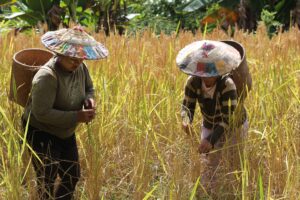
Credit: Perkumpulan Nurani Perempuan
Under the government’s Benefit Sharing Plan, endorsed and supervised by the World Bank, Long Isun has been disproportionately excluded from the promised benefits of the program. The mechanisms for participation and consent were formalities rather than genuine consultations. Information was often inaccessible, meetings were rushed, and community perspectives were ignored. When Long Isun voiced concerns about the project’s impact, they were met not with dialogue but with intimidation and reprisals. Government officials and project representatives labeled them as “troublemakers.” Community members received warnings that village development funds would be cut off if they refused to attend consultations. They were pressured by ER Project representatives, threatened with escalation to district authorities, and told that submitting a complaint could anger provincial leaders and risk future funding. These actions created fear, isolation, and coercion, silencing legitimate dissent and undermining the community’s right to freely and safely express concerns.
The harms faced by Long Isun are not incidental but the predictable outcome of the project’s design and the World Bank’s failure to uphold its own safeguard policies. The Bank proceeded with the ER Project despite being aware of the structural problems it would deepen: unresolved land tenure conflicts, delayed recognition of Indigenous status, and serious risks of exclusion. The Bank’s risk assessments identified these very issues, yet instead of ensuring preventive or corrective measures, it accepted flawed processes that entrenched discrimination and perpetuated harm.
The community now seeks to file a complaint with the World Bank’s independent accountability mechanism to prevent further harm, and remedy harm already incurred, with the World Bank’s support, and to advocate with the East Kalimantan Provincial government to document official recognition as Legally Recognized Indigenous Peoples / Masyarakat Hukum Adat (MHA) as a complementary effort.
-
The Story
The project
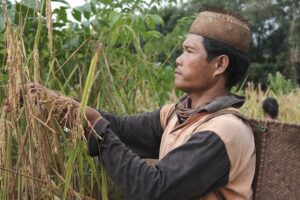
Amid golden rice fields ready for harvest, a member of the Long Isun Indigenous
community gently cuts each ripe stalk by hand using an ani-ani (also called gantuq), a
traditional harvesting knife passed down through generations of the Dayak Bahau Umaaq
Suling people. The image captures both the precision and care in this ancestral practice
known as Ngelunau, reflecting a deep respect for the land that sustains them (Credit:
Perkumpulan Nurani Perempuan).The Long Isun community’s history is deeply intertwined with the forests of East Kalimantan. For generations, they have lived along the upper Mahakam River, sustaining themselves through small-scale farming, fishing, hunting, and gathering forest products. Their land is not just a source of livelihood but the foundation of their identity, social structure, and spirituality. Every river bend, tree, and valley carries ancestral meaning. Their customary laws guide forest use, nurturing balance between people and nature, a system that has preserved the region’s biodiversity long before modern conservation programs existed.
Indonesia’s participation in the Forest Carbon Partnership Facility (FCPF) and its Emission Reduction (ER) Project reflects the country’s commitment to the global REDD+ (Reducing Emissions from Deforestation and Forest Degradation) framework. The ER Project in East Kalimantan, supported by the World Bank, aims to reduce carbon emissions by rewarding efforts to conserve forests and limit deforestation. The program is bound by the World Bank’s Environmental and Social Safeguards and Indonesia’s own SIS-REDD+ (Safeguard Information System for REDD+), both of which commit to respecting Indigenous rights, ensuring Free, Prior, and Informed Consent (FPIC), and protecting customary land tenure.
However, the lived reality in Long Isun reveals how these safeguards have been systematically undermined. An existing boundary conflict between the community and PT. Kemakmuran Berkah Timber (PT. KBT) predates the ER Project, but has been worsened by its implementation. Since 1966, Long Isun has had a well-documented customary territory, yet successive government decrees and private concessions eroded these rights. In 2008, the Ministry of Environment and Forestry granted PT. KBT a concession covering 82,810 hectares—13,150 of which overlap with Long Isun’s customary land. Despite clear objections, this lack of recognition became particularly critical under the ER Project.
The Long Isun community has repeatedly sought recognition of its MHA status and customary territory but continues to face administrative delays and lack of government response. Their 1966 boundary documentation and oral histories have not been formally recognized in regional spatial planning, leaving them vulnerable to overlapping claims from private companies and state conservation zones. Ironically, the ER Project’s own design documents acknowledge the existence of tenure conflicts and the limited recognition of MHA communities as a key social risk. Yet, despite this admission, the project has failed to develop or implement adequate mitigation measures. There are no clear procedures within the project to facilitate recognition of Indigenous territories and resolve boundary disputes.
Throughout the phases of the project (2018-2025), the project’s focus has remained fixed on technical reporting, carbon accounting, and institutional compliance, rather than Indigenous participation and consent. The lived realities of the people whose forests make the project possible have been ignored. The very communities who have preserved these forests are now denied recognition as rightful stewards. Their participation in decision-making was tokenistic, often conducted without translation to Dayak Bahau or genuine consent. This situation exposes a profound contradiction that while the ER Project and the World Bank publicly champion equity and safeguard compliance, the on-the-ground experience in Long Isun demonstrates the opposite.
Community concerns and the impact of the project on the community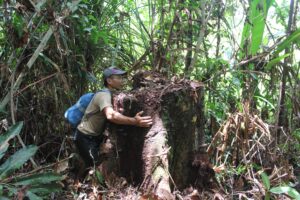
Credit: Perkumpulan Nurani Perempuan
From the outset, the Long Isun Indigenous community has faced a project that was neither transparent nor just. The ER Project has unfolded without meaningful consultation or consent, embedding discrimination and structural violence into its design.
- Lack of Meaningful Consultation and Sham FPIC: Consultations with Long Isun were perfunctory, misleading, and exclusionary. Meetings were conducted in Bahasa Indonesia, not the community’s Dayak Bahau language, and only a few representatives were invited to token sessions later misrepresented as “Free, Prior and Informed Consent” (FPIC). When community members finally attended a meeting in August 2024, believing it was about their land rights, they discovered it was instead only a carbon fund socialization. Their attendance was fraudulently recorded as consent. Despite formally revoking the forged consent, the ER Project continued to count Long Isun’s forests in its carbon calculations, which resulted in restriction of forest access.
- Violation of Customary Rights and Cultural Heritage: By treating ancestral forests as state property for carbon accounting, the ER Project erased Long Isun’s customary ownership and cultural connection to their land. The community’s ability to perform sacred forest rituals and rotational farming practices, integral to their identity and survival, has been curtailed without recognition or compensation.
- Exacerbation of Land Conflict: The ER Project intersected with a long-standing boundary dispute involving PT KBT, a timber company, and the neighboring community of Naha Aruq. Instead of taking measures in resolving these conflicts, the Project deepened them by incorporating contested territories into its carbon calculations.
- Structural Discrimination in Benefit Sharing: Under the Benefit Sharing Plan (BSP), only legally recognized Indigenous groups qualify for direct rewards, excluding unrecognized communities like Long Isun. This forces them into partnerships with concessionaires, including PT KBT, whose executives sit within the Project’s governance structure, creating clear conflicts of interest. The system institutionalizes exclusion and retraumatizes communities already harmed by corporate and state actors.
- Delayed Indigenous Recognition: Long Isun’s lack of formal recognition as an MHA locks them out of benefits, legal protections, and tenure security. In Mahakam Ulu, none of the 50 villages have yet received recognition. Long Isun was the first indigenous community from Mahakam Ulu who applied for the MHA back in 2018. Without the MHA, Long Isun will not be able to access the benefits designated for recognized indigenous peoples in the Benefit Sharing Plan, and their lands can be given for concessions without their consent. The Project’s failure to address this systemic barrier has entrenched discrimination and perpetuated vulnerability.
- Forced Inclusion and Misuse of Village Funds: Even after revoking consent, Long Isun’s forest continues to generate carbon credits for state profit. Funds were deposited into the village account without the community’s approval.
- Threats to Livelihoods and Food Security: The ER Project has resulted in restrictions on customary practices such as swidden farming and controlled burning, central to food security and ecological balance, without providing alternatives.
- Fear, Retaliation, and Coercion: When Long Isun refused to attend consultations, local officials threatened to withdraw village funding, compelling participation under duress. Community members and allies faced intimidation, with officials warning that advocacy could “antagonize” local governments and block development funds. Such coercion nullifies any notion of “free” consent and violates the Bank’s safeguards against reprisals.
- Gendered Harms and Exclusion: Indigenous women, the backbone of forest stewardship and food security, were excluded from consultations and decision-making. Restrictions on forest use have undermined women’s livelihoods in foraging, farming, and weaving, while the absence of gender-sensitive grievance mechanisms left them without recourse. These impacts deepen gender inequality and contravene the Bank’s own gender and safeguard policies. Moreover, by labeling extractive activities as environmentally sustainable, the ER Project has effectively incentivized continued commercial exploitation under a “green” label, further marginalizing Indigenous women and deepening both gender and environmental inequities.
World Bank’s Contribution to Harm
In November 2020, the World Bank approved the ER Project with total funding of US$ 110 million. The funding is said to be distributed amongst relevant stakeholders in accordance with a pre-agreed BSP.
Two years later, in November 2022, the World Bank gave an advance payment to Indonesia Environmental Fund/Badan Pengelola Dana Lingkungan Hidup (BPDLH) of USD 20,900,000, consisting of Tranche A amounting to USD 1,120,710 and Tranche B amounting to USD 19,799,290, equivalent in total to payment for 4,180,000 tons of CO₂ emissions reduced.
Raising Concerns with the East Kalimantan Authority and the World Bank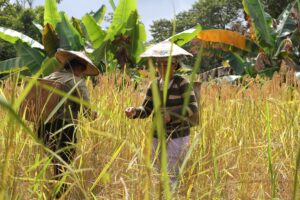
Community members of Long Isun work together under the warm sunlight, surrounded
by ripened rice swaying in the breeze. Their annual harvest marks not only a season of
abundance but also a celebration of balance between people and nature, an enduring
connection that ensures the earth continues to provide all they need until the next
Ngelunau comes (Credit: Perkumpulan Nurani Perempuan).Since the launch of the ER Project, the Long Isun community, supported by civil society organizations and Indigenous rights advocates, has repeatedly raised concerns over the lack of consultation, exclusion from benefit-sharing, and violations of customary land rights. These efforts have included formal letters, community meetings with district and provincial authorities, and direct communication with the World Bank’s project management team in Jakarta.
Despite these sustained efforts, the community’s calls for remedy and recognition have been met with prolonged silence, bureaucratic deflection, and fragmented responses.
Local Indigenous leaders have sought recognition under Indonesia’s Masyarakat Hukum Adat (MHA) framework. However, since their applications have faced indefinite delays. As a result, the legally unrecognized communities like Long Isun remain effectively excluded from fair participation in the ER Project’s BSP.
In 2021, community representatives raised these issues during the World Bank’s Benefit Sharing Plan consultation process, emphasizing that no Free, Prior, and Informed Consent (FPIC) was ever obtained before their forests were included in the ER accounting area. Nevertheless, the Bank proceeded with project approval, citing the inclusion of “provincial-level consultations” as sufficient under its safeguard compliance framework. Despite repeated requests from the community for the Bank to facilitate meetings with PKTHA to resolve ongoing land boundary disputes and to address the delayed Masyarakat Hukum Adat (MHA) recognition process, no formal remediation has been initiated, and engagement with affected households remains limited.
Faced with the continued absence of accountability, the community and its allies are now considering escalating the matter to the World Bank’s Accountability Mechanism. Through this pathway, we hope to facilitate constructive discussions to address key concerns, including the lack of FPIC, absence of transparency, and the exclusion of unrecognized indigenous communities. The community’s priority is to achieve a fair resolution through a meaningful dialogue with WB and relevant government stakeholders.
Complaint to the Inspection Panel
After years of raising unaddressed concerns about the social, cultural, and environmental harms resulting from the inclusion of their customary forest in the ER Project, the Long Isun community, supported by Perkumpulan Nurani Perempuan, Accountability Counsel, and Forest Project People as advisors, formally submitted a complaint to the World Bank’s Inspection Panel on 3 November 2025. The complaint has been endorsed by the communities, and was developed through rigorous documentation, in-depth consultations, and direct input from affected households.
In the complaint, the communities raise the issues outlined above and demand the following (summary):
- Suspend Remaining Disbursements: The Bank must immediately suspend the final USD 89.1 million disbursement until its accountability mechanism concludes its complaint process. Continuing payments while violations persist would deepen harm, potentially irreversibly.
- Halt Project Activities in Long Isun Territory: All ER Project activities must cease immediately until the land conflict between Long Isun, Naha Aruq, and timber company PT. KBT is resolved, and Long Isun’s MHA recognition is finalized.
- Respect Long Isun’s Decision to Opt Out: The Bank and the government must remove Long Isun’s forests from benefit calculations and stop fund allocations and forest access restrictions made without consent.
- Acknowledge Harms and Ensure Remedy: The community demands formal recognition of these harms and corrective actions consistent with Bank policies.
- Revise the Benefit Sharing Plan (BSP): The BSP must be overhauled to guarantee equitable and direct benefits for Indigenous Peoples. Free from state or corporate control and to ensure benefit distribution does not exacerbate land disputes.
Case partners
Accountability Counsel is partnering on this case with Perkumpulan Nurani Perempuan (PNP) who works for gender justice, democracy and a sustainable environment for social justice. We also partner with the Forest Peoples Program (FPP), a non-governmental organization that works with forest people to protect their rights and their forest.
-
The Case
-
Nov 2025
Community filed a complaint to the World Bank’s Accountability Mechanism.
-
Sep 2024
Between September 2024 and October 2025, continued engagements with the GRS, which to date have been unsatisfactory to meet Long Isun’s concerns.
-
Aug 2024
A fraudulent FPIC took place. The Long Isun community was invited to a MHA verification meeting, but it turned out to be an ER Project socialization. The attendance list of this meeting was then used as a proof of ‘consent’. The community immediately revoked the forged consent, and officially opted out from the ER Project.
-
Mar 2024
Multiple retaliation instances occurred between March and July 2024. In March 2024, PNP was threatened by a state official, the official mentioned that if the government does not receive money from the World Bank, it cannot accelerate the MHA process in other district, and “if the complaint were to be pursued and followed through, the funding, due to be received, to the whole province would be at risk of being withdrawn.” For this reason, “PNP would be at risk of being antagonised by all 10 districts for impeding the World Bank funding process and preventing the MHA recognition process in these districts.” In June 2024, the Village Chief of Long Isun received a text message that threatened to cut off Long Isun’s village fund.
-
Mar 2024
Community filed a complaint to the Grievance Redress Mechanism (GRS) in order to address harms caused by the ER Project. The community highlighted the need to resolve land boundary disputes, delayed recognition of MHA, failures in obtaining Free, Prior, and Informed Consent (FPIC) and discriminatory Benefit Sharing Plan (BSP).
-
Jan 2022
In 2022 and 2023, engagement meetings under the ER Project continued; however, communities reported that they never fully understood the project’s benefits, and potential negative impacts were not communicated. The process was described by the community as misleading.
-
Jan 2019
In 2019 and 2020, engagement with the ER Project remained limited, partly due to the impact of the COVID-19 pandemic. Despite reduced interactions, Long Isun consistently maintained its position of rejecting the project.
-
Jan 2018
Socialisation of the Emissions Reduction (ER) Project began via the Direktorat Jenderal Pengendalian Perubahan Iklim (DPPI, MoEF); Long Isun consistently rejected participation as their land-boundary and MHA recognition conflicts remain unresolved. The conflict between Long Isun, PT. KBT and Naha Aruq reached an agreement. The disputed forest areas are declared ‘status quo’ pending to be processed into customary forest. However, it requires MHA status for Long Isun to convert the disputed forest into customary forest.
-
Jan 2014
Long Isun community members discovered that PT. KBT was cutting the trees inside Long Isun’s forest area without their consent. This exchange resulted in a criminalization of one community member who stopped the tree-cutting operation. Backed by criminalization and arrests, PT. KBT’s actions have harmed the Long Isun community’s economy, social life, and culture.
-
Jan 1966
In 1966, the Long Isun land boundary was formally documented. However, in 2008, the Ministry of Forestry and Environment extended PT. Kemakmuran Berkah Timber’s (PT. KBT) logging permit in Long Pahangai District to cover 82,810 ha, including 13,150 ha within Long Isun’s customary land, which the community rejected. In 2011, a Kutai Barat Mayor’s decree redefined village boundaries, and PT. KBT, with support from The Nature Conservancy (TNC), used this to claim the disputed area, disregarding the original 1966 boundary and violating the Minister of Home Affairs Regulation No. 27/2006.
-
-
Impact
The ER Project has deeply disrupted the social fabric, land rights, and cultural integrity of the Long Isun Indigenous community. Despite their explicit refusal to participate, project activities continued on their customary lands, causing loss of trust and growing tension with neighboring villages and authorities.
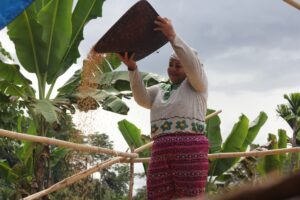
Credit: Perkumpulan Nurani Perempuan
The community’s lack of legal recognition as Masyarakat Hukum Adat (MHA) has left them without formal protection against land encroachment and benefit-sharing exclusion. Forest areas vital for livelihoods, such as small-scale land burning and tree-cutting have been restricted under the ER framework, worsening economic and food insecurity. Retaliation and intimidation have further eroded community safety. Reports include threats to cut off village development funds and pressure against leaders opposing the project. These reprisals have created a climate of fear, discouraging open dialogue and participation.
The formal complaint to the World Bank’s Inspection Panel marks a critical step for the Long Isun Indigenous community, a collective demand for justice, transparency, and accountability. It reflects years of unheeded concerns and seeks recognition of the harms caused by the East Kalimantan ER Project’s failure to uphold core safeguard principles, including Free, Prior and Informed Consent (FPIC) and gender inclusion. The community’s pursuit of remedy is not only about halting harmful activities, but about reclaiming their right to self-determination, protection of their ancestral lands, and restoration of their livelihoods and dignity. The complaint calls for an immediate suspension of disbursements, cessation of activities in their territory, and acknowledgment of their decision to opt out.
We stand in solidarity with the Long Isun community as they navigate the accountability mechanism process, ensuring their experiences are documented and their voices amplified. Beyond the Panel, this case serves as a broader call for accountability within climate finance, demanding that development and carbon projects respect Indigenous rights, promote gender equity, and deliver true climate justice rather than perpetuating harm.
-
Case Media
“Long Isun’s land is not just territory — it is history, identity, and survival. Yet the World Bank allowed this project to move forward without resolving the land conflict and without recognizing the community’s rights. This is not just a failure of the government — it is a failure of the Bank to uphold the very safeguards it claims to enforce.” – Martha Doq, PNP
“What is carbon? Is it important for Long Isun? Are they going to collect it and ship it off to other countries?” – Long Isun Community Member
Media Coverage
- 4 December 2025 Tolak Proyek Karbon, Masyarakat Long Isun Surati Bank Dunia By Niken D. Sitoningrum, Mongabay
- 1 February 2023 Long Isun Fights for Borneo’s Vanishing Rainforests By Rainforest Action Network
- 15 December 2020 Breaking the Heart of Borneo: New FPP report raises alarm By Forest Peoples Programme
Press Releases
- 6 November 2025 Long Isun Community Pushes for Mediation in Formal Complaint Against World Bank Carbon Project in Indonesia / Masyarakat Long Isun Mendorong untuk Diadakannya Mediasi dalam Komplain Resmi terhadap Proyek Karbon oleh Bank Dunia di Indonesia By Accountability Counsel, Perkumpulan Nurani Perempuan, and Forest Peoples Programme

